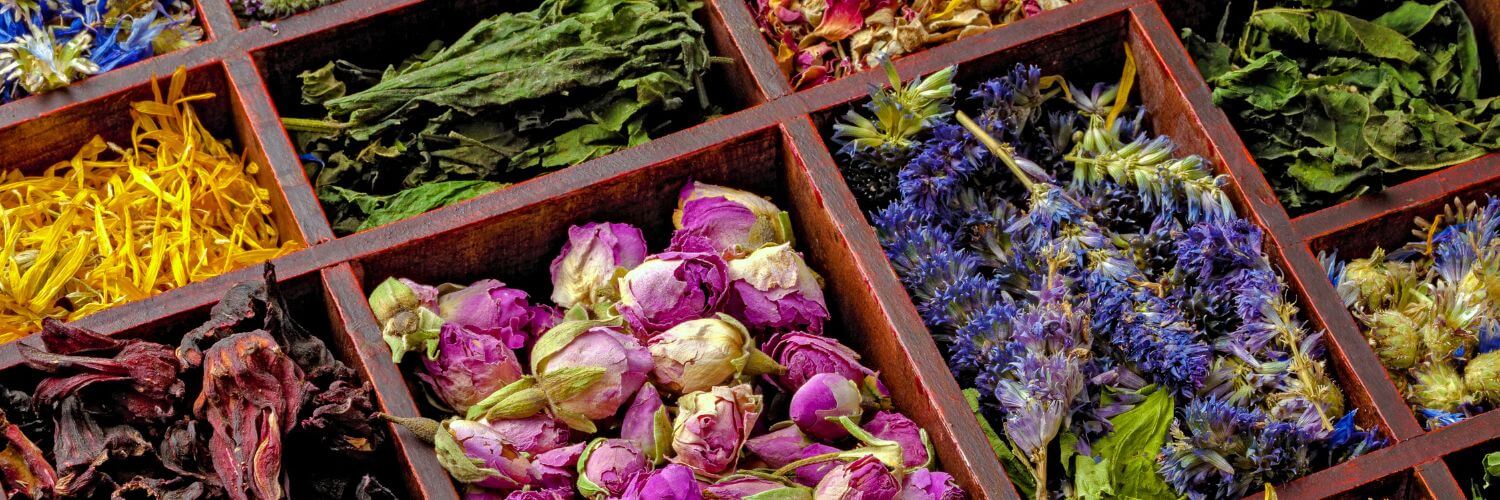製作自己的花草茶
家庭製作花草茶的入門指南
幾個世紀以來,草藥茶因其舒緩特性和健康益處而受到不同文化的珍惜。無論您是想在漫長的一天後放鬆一下,還是尋求治療常見疾病的自然療法,草藥茶都能為您帶來愉悅的治療體驗。
概述

在本指南中,我們將探討您在家中製作自己的涼茶所需了解的所有知識。從了解草藥茶的基礎、選擇和混合草藥,到掌握沖泡藝術,我們為您提供全方位的服務。閱讀本文後,您將擁有知識和信心來製作符合您口味和健康需求的個人化花草茶混合物。
1. 了解花草茶
定義和好處
草本茶,也稱為藥草茶,是一種用熱水浸泡或煎煮草藥、香料、水果和其他植物材料製成的飲料。與傳統茶(紅茶、綠茶、白茶)不同,草本茶不含茶樹植物的茶葉,這意味著它們天然不含咖啡因。對於那些尋求舒緩和不含咖啡因的飲料的人來說,這是一個絕佳的選擇。
草藥茶的健康益處
草本茶因其廣泛的健康益處而受到讚譽,具體益處取決於所使用的草本。一些常見的好處包括:
- 消化健康:眾所周知,薄荷茶和薑茶等有助於消化和緩解胃部不適。
- 放鬆和睡眠:洋甘菊和薰衣草茶因其鎮靜作用而廣受歡迎,有助於促進放鬆並改善睡眠品質。
- 免疫支持:紫錐菊和接骨木等草藥經常用於茶中,以增強免疫系統並抵抗感冒和流感。
受歡迎的茶用草藥
選擇正確的草藥對於製作美味且有益的草藥茶至關重要。以下是草藥茶中常用的一些草藥:
- 洋甘菊:洋甘菊茶以其鎮靜功效而聞名,非常適合放鬆和幫助睡眠。 購買洋甘菊
- 薄荷:薄荷茶具有清爽的口感,有助於消化,舒緩胃部。 購買薄荷
- 芙蓉:芙蓉茶是一種味酸、濃鬱的草本植物,富含抗氧化劑,有益於心血管健康。 購買芙蓉
- 薑:薑茶辛辣溫熱,有利於消化和增強免疫系統。 購買生薑
- 薰衣草:這種芳香的草本植物有助於放鬆,並有助於緩解壓力和焦慮。 購買薰衣草
製作涼茶的必備工具
基本裝置
為了泡出一杯完美的花草茶,擁有合適的工具至關重要。以下是您需要的一些基本設備:
- 茶壺:沖泡花草茶時,優質的茶壺至關重要。陶瓷、玻璃或鑄鐵茶壺是受歡迎的選擇,因為它們保溫性好,而且易於清潔。
- 浸泡器:浸泡器用於在熱水中浸泡散裝草藥。其種類繁多,包括網球型、矽膠型、籃子式浸泡器等。
- 水壺:一個好的水壺對於將水加熱到適當的溫度是必要的。具有溫度控制功能的電熱水壺特別有用,可以確保水適合不同類型的草藥。
可選配件

雖然基本工具可以幫助您入門,但一些可選配件可以增強您的草藥茶製作體驗:
- 溫度計:確保水溫適宜會對茶的味道產生很大的影響。溫度計可以幫助您沖泡出完美的咖啡。
- 茶濾:如果您喜歡直接在茶壺中沖泡散裝草藥,則茶濾將有助於倒茶,而不會讓草藥進入杯中。
- 儲存罐:適當的儲存對於保持草藥的新鮮度和效力至關重要。密封的玻璃罐是保持草藥乾燥並避免光照和潮濕的理想選擇。
建議
為了獲得最佳效果,投資高品質的工具可以增強草藥茶的風味和健康益處。以下是一些建議:
- 陶瓷茶壺:保溫性佳,易於清潔。
- 不鏽鋼網狀浸泡器:耐用且足夠精細,可防止細小的草本顆粒逸出。
- 帶有溫度控制的電熱水壺:確保您可以將水加熱到適合不同草藥的溫度。
- 帶密封蓋的玻璃儲物罐:讓您的香草保持新鮮和美味。
擁有合適的工具可以讓您製作和享用自己的涼茶的過程成為一種愉快而令人滿意的體驗。
在家調配花草茶
選擇你的藥草
創建您自己的草本茶混合物可讓您客製化適合您的喜好和需求的口味和健康益處。以下是選擇最佳草藥的一些技巧:
- 風味特徵:考慮您喜歡的風味。有些草藥味道濃烈而獨特,有些草藥味道則比較淡雅。混合互補的口味可以創造出均衡的混合口味。
- 健康益處:根據健康益處選擇草藥。例如,洋甘菊有利於放鬆,而生薑則有助於消化。
- 品質:始終使用高品質的有機草藥,以確保最佳風味和健康益處。
混合技術
調配草本茶既是一門藝術,也是一門科學。以下有一些技巧可以幫助您製作美味又有效的混合物:
- 口味平衡:從佔混合物約 50-70% 的基礎草本植物開始。加入次要草藥來補充基料,最後加入少量重點草藥來增添風味或增加健康益處。
- 比例:典型的混合物可能是 2 份基本草本植物、1 份次要草本植物和 0.5 份重點草本植物。依口味調整比例。
- 實驗:不要害怕嘗試不同的組合。記錄你的混合物以記住哪種效果最好。
客製化提示
以下是一些根據您的口味和健康需求量身訂製花草茶混合物的技巧:
- 增味劑:添加乾果、柑橘皮或香料(如肉桂、小荳蔻)等成分來增強風味。
- 健康重點:客製化您的混合物以解決特定的健康問題。例如,混合薄荷和生薑有益於消化健康,或混合洋甘菊和薰衣草有益於放鬆。
- 甜味劑:如果您喜歡甜茶,可以考慮添加天然甜味劑,如蜂蜜、甜菊糖或甘草根。
混合範例
以下是一些可供您入門的範例混合物:
請記住,製作自己的草本茶混合物的樂趣在於能夠進行實驗並發現自己最喜歡的組合。繼續調整和品嚐,直到找到完美的混合。
沖泡花草茶
沖泡基礎
沖泡花草茶是一門藝術,需要正確的技術才能從花草中提取出最佳的風味和健康益處。以下是沖泡一杯完美花草茶的一些基本技巧:
- 水質:使用過濾水可獲得最佳口感。自來水中可能含有影響茶的味道的雜質。
- 水溫:與傳統茶不同,大多數草本茶需要沸水(約 212°F 或 100°C)。然而,有些嬌嫩的藥草可能需要稍微涼一點的水,以避免苦味。
- 浸泡時間:草本茶通常需要比傳統茶更長的浸泡時間。將草藥浸泡至少 5-10 分鐘,以確保最佳風味和功效。
一步步沖泡指南
請按照以下步驟泡一杯美味的花草茶:
- 測量您的草藥:每杯水使用約 1-2 茶匙乾草藥。根據您的口味偏好和草藥的濃度調整用量。
- 煮開水:將水加熱至沸騰。如果您使用具有溫度控制的水壺,請將其設定為 212°F (100°C)。
- 準備泡茶器:將量好的草藥放入泡茶器中,或者如果您打算稍後過濾茶,則直接放入茶壺中。
- 加水:將沸水倒入泡茶器或茶壺中的草藥中。
- 泡茶:蓋上蓋子,讓茶浸泡 5-10 分鐘。有些草藥可能需要較長的浸泡時間;根據您使用的具體草藥進行調整。
- 過濾並上桌:如果您直接在茶壺中泡茶,請在上桌前過濾茶草藥。否則,請取出注入器。將茶倒入杯中然後享用。
泡出完美茶飲的秘訣
為了確保您總是可以泡出一杯完美的花草茶,請牢記以下提示:
- 嘗試不同的浸泡時間:不同的草藥可能需要不同的浸泡時間才能帶出其最佳味道。從建議的時間開始並根據您的口味進行調整。
- 使用新鮮的草藥:新鮮是製作美味且有益的茶的關鍵。確保您的草藥已妥善儲存並在保質期內使用。
- 避免過度浸泡:雖然浸泡時間較長可以增強風味,但浸泡過度有時會導致苦味,尤其是對於嬌嫩的香草而言。
提升你的茶
為了進一步提升您的茶的品質,請考慮添加:
- 甜味劑:蜂蜜、甜菊糖或龍舌蘭糖漿可以增添一絲甜味。
- 柑橘:一片檸檬或柳橙可以增添味道。
- 香料:肉桂、小荳蔻或丁香可以為您的茶增添溫暖和複雜性。
透過遵循這些指導方針並嘗試不同的技術,您將能夠沖泡不僅美味而且富含健康益處的草本茶。
草本茶食譜
製作自己的花草茶混合物既有趣又有益。以下是一些可幫助您入門的簡單和高級食譜:
適合初學者的簡單食譜
這些易於製作的混合物僅需要幾種原料,非常適合初學者。
鎮靜甘菊茶
清爽薄荷茶
高級家庭茶飲配方
對於想要嘗試更複雜口味的人來說,這些先進的配方提供了更豐富、更細緻入微的茶體驗。
增強免疫力混合物
香料薑茶
- 2茶匙薑
- 1 茶匙肉桂皮(未提供肉桂連結)
- 0.5 茶匙丁香(未提供丁香連結)
- 浸泡10至12分鐘。
特色茶
這些食譜針對特定的健康益處,非常適合納入您的保健常規中。
消化舒適茶
放鬆睡眠茶
透過嘗試這些食譜並根據您的口味進行調整,您將能夠根據您的喜好和需求製作出美味又有益的涼茶。
儲存和保存草藥茶
正確儲存草藥茶對於保持其新鮮度、風味和效力至關重要。以下是一些確保您的草藥保持最佳狀態的指南。
儲存技巧
密封容器:將乾草藥存放在密封容器中,防止暴露在空氣中,因為這樣會降低其品質。密封的玻璃罐是理想的選擇。
陰涼、黑暗處:將草藥存放在陰涼、黑暗處,遠離陽光直射和高溫。光和熱會導致草藥失去其味道和藥用價值。
乾燥環境:確保儲存區域乾燥。潮濕會導致發黴和變質。考慮在容器中添加一包矽膠來吸收多餘的水分。
標籤:在容器上貼上藥草名稱和儲存日期的標籤。這將幫助您追蹤新鮮度並確保您首先使用最古老的草藥。
保存期限
乾草藥的保存期限有所不同,但一般來說,如果儲存得當,其藥效可以保持 6 個月到一年。以下是一些一般準則:
- 葉類草本植物(例如薄荷、洋甘菊) :這些草本植物通常可以保持新鮮長達一年。
- 根和樹皮(例如生薑、肉桂) :這些具有較長的保質期,並且可以保持新鮮長達兩年。
- 花朵(如薰衣草、芙蓉花) :這些花朵比較嬌嫩,應在 6 個月至一年內使用。
保持新鮮度的秘訣
- 定期檢查:定期檢查儲存的草藥是否有變質跡象,例如顏色、氣味的變化或出現黴菌。
- 小批量:如果可能的話,請小批量購買或乾燥草藥,以確保在它們仍然新鮮時使用。
- 根據需要研磨:為達到最大功效,請將草藥以完整形式儲存,並在使用前研磨。這有助於保留它們的精油和風味。
讓陳腐的藥草恢復活力
如果您的草藥已經失去了部分效力但仍然可以安全使用,您可以稍微恢復它們的效果:
- 熱激活:將草藥放在乾鍋中輕輕烘烤幾分鐘,以釋放其精油。小心不要燒壞它們。
- 蒸氣提神:將藥草放在濾網中,置於一鍋蒸水上,蒸幾秒鐘。這有助於恢復它們的香氣和味道。
透過遵循這些儲存和保存技巧,您可以確保您的涼茶盡可能長時間保持新鮮、美味和有效。
常見問題 (FAQ)
製作和享用草藥茶可能會引發許多問題。以下是一些常見問題及其解答,希望能幫助您了解草藥茶的旅程。
常見問題
草本茶與傳統茶有何不同?
- 草本茶,也稱為藥草茶,由多種植物材料製成,包括草藥、香料、花卉和水果,而傳統茶(紅茶、綠茶、白茶)則由茶樹植物的葉子製成。與傳統茶不同,草本茶天然不含咖啡因。
我怎麼知道該用哪種草藥來泡茶?
- 根據您的口味偏好和期望的健康益處選擇草藥。例如,洋甘菊和薰衣草有利於放鬆,而薄荷和生薑則有助於消化。嘗試不同的組合來找到您最喜歡的。
我可以用新鮮藥草代替乾燥藥草嗎?
- 是的,您可以使用新鮮的香草。然而,您需要使用比乾燥草藥更多的新鮮草藥,因為乾燥草藥的濃度更高。通常,新鮮草藥的用量是乾草藥的三倍。
我應該將涼茶泡多久?
- 大多數花草茶應浸泡 5-10 分鐘。一些根和樹皮可能需要更長的浸泡時間,長達 15-20 分鐘。根據具體的草藥和您的口味偏好進行調整。
我可以將不同的草藥混合在一起嗎?
- 絕對地!混合不同的草藥可以產生獨特的風味並增強健康益處。只要確保平衡口味並考慮每種草藥的特性即可。
我該如何儲存我的涼茶?
- 將乾草藥存放在密封容器中,放置在陰涼、乾燥的地方。適當的儲存可以確保草藥盡可能長時間保持新鮮和效力。
有哪些草藥是我該避免的?
- 雖然許多草藥是安全的,但有些草藥可能會產生強烈的副作用或與藥物產生交互作用。在使用不熟悉的草藥之前,請務必研究或諮詢醫療保健提供者,特別是當您有健康問題或懷孕時。
有哪些常見的草藥茶配方具有特定的健康益處?
- 放鬆與睡眠:洋甘菊、薰衣草與檸檬香蜂草。
- 助消化:薄荷、生薑和茴香。
- 增強免疫力:紫錐菊、接骨木和玫瑰果。
我可以為我的涼茶加糖嗎?
- 是的,您可以使用蜂蜜、甜菊糖或龍舌蘭糖漿等天然甜味劑來使您的花草茶變得更甜。依您的口味調整用量。
製作涼茶需要什麼設備?
- 基本設備包括茶壺、茶泡器和水壺。溫度計和茶濾等選購配件可以增強您的泡茶體驗。
其他提示
- 實驗:不要害怕嘗試新的草藥和混合物。記下最適合您的方法。
- 保持知情:了解不同草藥的特性和好處,以便做出明智的選擇。
- 享受過程:製作和飲用涼茶是一種輕鬆而愉快的儀式。花點時間來欣賞其味道和香氣。
這些常見問題解答應該可以幫助您入門並自信地製作和享用自己的涼茶。
重點總結
在家製作自己的花草茶是一個有益且愉快的過程,您可以根據自己的喜好客製化口味和健康益處。以下是我們已經討論過的內容的簡要回顧:
- 了解草本茶:草本茶由多種植物材料製成,具有多種健康益處,但不含傳統茶中的咖啡因。
- 基本工具:投資優質茶壺、茶泡器和水壺。溫度計和儲物罐等可選配件可以增強您的泡茶體驗。
- 混合草藥茶:根據口味和健康益處選擇草藥,並使用混合技術來創造均衡有效的茶混合物。
- 沖泡花草茶:遵循基本的沖泡指南來沖泡一杯完美的茶,並使用技巧來增強茶的味道和效力。
- 草本茶食譜:嘗試簡單和高級的食譜來找到您最喜歡的混合茶。
- 儲存和保存:適當的儲存可確保您的草藥保持新鮮和效力。遵循我們的提示來保持您的涼茶的品質。
- 常見問題:解答常見問題可以幫助您對泡茶之旅更有信心。
製作草藥茶的藝術是科學與創造力的完美結合。不要害怕嘗試不同的草藥和食譜。練習越多,您就越能發現什麼最適合您的口味和健康需求。
我們鼓勵您今天就開始您的涼茶之旅。造訪我們的產品頁面,購買高品質的有機草藥並開始製作您的個人化混合物。在下面的評論中或在我們的社交媒體頻道上與我們分享您的經驗和食譜。
如需了解更多資訊並了解我們種類繁多的草藥,請造訪我們的網站: Sacred Plant Co 。
其他資源
產品推薦
我們希望本指南能激發您探索奇妙的草本茶世界的興趣。享受這個過程和隨之而來的許多好處!





